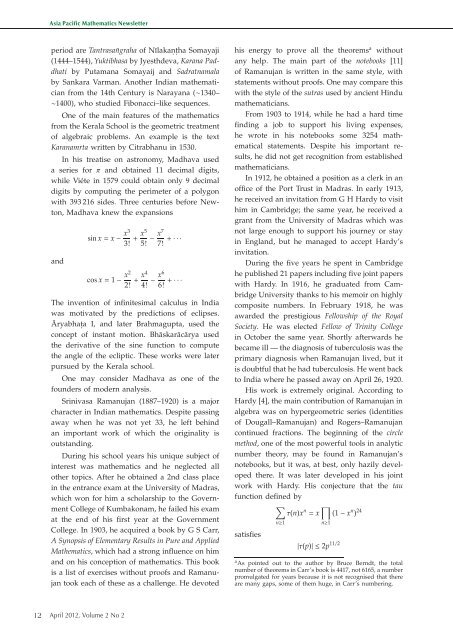Mathematics Newsletter
Mathematics Newsletter
Mathematics Newsletter
Create successful ePaper yourself
Turn your PDF publications into a flip-book with our unique Google optimized e-Paper software.
12<br />
Asia Pacific <strong>Mathematics</strong> <strong>Newsletter</strong><br />
period are Tantrasa¯ngraha of Nīlakan. t . ha Somayaji<br />
(1444–1544), Yuktibhasa by Jyesthdeva, Karana Paddhati<br />
by Putamana Somayaij and Sadratnamala<br />
by Sankara Varman. Another Indian mathematician<br />
from the 14th Century is Narayana (∼1340–<br />
∼1400), who studied Fibonacci–like sequences.<br />
One of the main features of the mathematics<br />
from the Kerala School is the geometric treatment<br />
of algebraic problems. An example is the text<br />
Karanamrta written by Citrabhanu in 1530.<br />
In his treatise on astronomy, Madhava used<br />
a series for π and obtained 11 decimal digits,<br />
while Viéte in 1579 could obtain only 9 decimal<br />
digits by computing the perimeter of a polygon<br />
with 393 216 sides. Three centuries before Newton,<br />
Madhava knew the expansions<br />
and<br />
sin x = x − x3 x5 x7<br />
+ − + ···<br />
3! 5! 7!<br />
cos x = 1 − x2 x4 x6<br />
+ − + ···<br />
2! 4! 6!<br />
The invention of infinitesimal calculus in India<br />
was motivated by the predictions of eclipses.<br />
Āryabhat . a I, and later Brahmagupta, used the<br />
concept of instant motion. Bhāskarācārya used<br />
the derivative of the sine function to compute<br />
the angle of the ecliptic. These works were later<br />
pursued by the Kerala school.<br />
One may consider Madhava as one of the<br />
founders of modern analysis.<br />
Srinivasa Ramanujan (1887–1920) is a major<br />
character in Indian mathematics. Despite passing<br />
away when he was not yet 33, he left behind<br />
an important work of which the originality is<br />
outstanding.<br />
During his school years his unique subject of<br />
interest was mathematics and he neglected all<br />
other topics. After he obtained a 2nd class place<br />
in the entrance exam at the University of Madras,<br />
which won for him a scholarship to the Government<br />
College of Kumbakonam, he failed his exam<br />
at the end of his first year at the Government<br />
College. In 1903, he acquired a book by G S Carr,<br />
A Synopsis of Elementary Results in Pure and Applied<br />
<strong>Mathematics</strong>, which had a strong influence on him<br />
and on his conception of mathematics. This book<br />
is a list of exercises without proofs and Ramanujan<br />
took each of these as a challenge. He devoted<br />
April 2012, Volume 2 No 2<br />
his energy to prove all the theoremsa without<br />
any help. The main part of the notebooks [11]<br />
of Ramanujan is written in the same style, with<br />
statements without proofs. One may compare this<br />
with the style of the sutras used by ancient Hindu<br />
mathematicians.<br />
From 1903 to 1914, while he had a hard time<br />
finding a job to support his living expenses,<br />
he wrote in his notebooks some 3254 mathematical<br />
statements. Despite his important results,<br />
he did not get recognition from established<br />
mathematicians.<br />
In 1912, he obtained a position as a clerk in an<br />
office of the Port Trust in Madras. In early 1913,<br />
he received an invitation from G H Hardy to visit<br />
him in Cambridge; the same year, he received a<br />
grant from the University of Madras which was<br />
not large enough to support his journey or stay<br />
in England, but he managed to accept Hardy’s<br />
invitation.<br />
During the five years he spent in Cambridge<br />
he published 21 papers including five joint papers<br />
with Hardy. In 1916, he graduated from Cambridge<br />
University thanks to his memoir on highly<br />
composite numbers. In February 1918, he was<br />
awarded the prestigious Fellowship of the Royal<br />
Society. He was elected Fellow of Trinity College<br />
in October the same year. Shortly afterwards he<br />
became ill — the diagnosis of tuberculosis was the<br />
primary diagnosis when Ramanujan lived, but it<br />
is doubtful that he had tuberculosis. He went back<br />
to India where he passed away on April 26, 1920.<br />
His work is extremely original. According to<br />
Hardy [4], the main contribution of Ramanujan in<br />
algebra was on hypergeometric series (identities<br />
of Dougall–Ramanujan) and Rogers–Ramanujan<br />
continued fractions. The beginning of the circle<br />
method, one of the most powerful tools in analytic<br />
number theory, may be found in Ramanujan’s<br />
notebooks, but it was, at best, only hazily developed<br />
there. It was later developed in his joint<br />
work with Hardy. His conjecture that the tau<br />
function defined by<br />
�<br />
τ(n)x n �<br />
= x (1 − x n ) 24<br />
satisfies<br />
n≥1<br />
n≥1<br />
|τ(p)| ≤2p 11/2<br />
a As pointed out to the author by Bruce Berndt, the total<br />
number of theorems in Carr’s book is 4417, not 6165, a number<br />
promulgated for years because it is not recognised that there<br />
are many gaps, some of them huge, in Carr’s numbering.<br />
2


